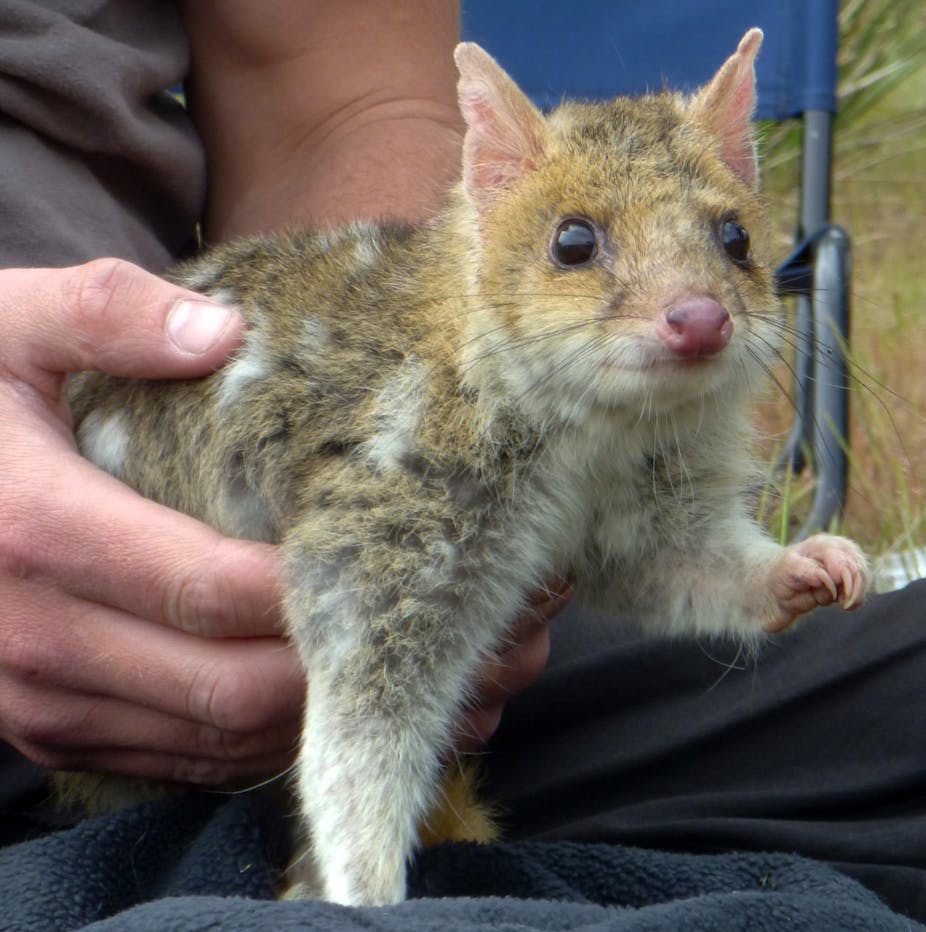With sharp teeth and an attitude to match, quolls are some of Australia’s most impressive hunters. Ranging from around 300g to 5kg, these spectacularly spotted marsupials do an out-sized job of controlling invasive pasture grubs and rodents, as well as cleaning up carcasses. They are even credited with thwarting early attempts to establish the rabbit in Australia.
But our quolls are in trouble. The recent Action Plan for Australian Mammals highlighted their extraordinary decline. Collectively, these species once occurred in high numbers across the country. Now they are all considered threatened, although not all state, federal and international listings reflect these current assessments.
Fortunately there are some signs of hope for one group of quolls, which we need to learn from if we’re to save these small but fierce Australian predators from going the way of too many other unique mammals, including the Tasmanian tiger.
Northern quoll

Our smallest and most endangered quoll once occurred across northern Australia, from eastern Queensland to the West Australian Pilbara. But over the last century, it has disappeared from vast areas, while numbers have crashed in many others, probably due to the effects of pastoralism, changed fire regimes and feral cats.
However, its nemesis has been the cane toad, which poisons and kills quolls that try to eat them. Northern quoll populations have disappeared from vast areas immediately following the spread of toads. Even island populations of northern quolls have disappeared as toads rafted in on debris or flood-waters. It is a most unusual ecological quirk, with a prey species wiping out a predator over vast areas.
However there is hope. Some populations have persisted in toad-invaded areas, possibly because some individuals were never keen frog-eaters or because they have learnt to avoid toads. In an interesting piece of ecological engineering, researchers have also had some success teaching quolls to avoid toads following taste-aversion training.
Despite these hopeful signs, their outlook in the next few years is for ongoing catastrophic decline, mainly in the recently toad-invaded Kimberley region.
Spotted-tailed quoll

Mainland Australia’s largest marsupial carnivore, the spotted-tailed quoll, is a creature now verging on the mythical. Populations plummeted within decades of European settlement in their forest habitats along Australia’s eastern seaboard and in Tasmania, where they are second in size only to the Tasmanian devil.
Their position near the top of the food-chain, low densities, reproductive traits and dangerous behaviour make spotted-tailed quolls highly sensitive to landscape changes that accompany settlement. Even today, their mobility and opportunistic behaviour exposes them to a range of threats, including dogs, foxes, cane toads, cars, and retaliatory killing at chook-pens.
This ecological fragility may explain why spotted-tailed quolls are not found in many areas of suitable and protected habitat. Most protected areas are not large enough to sustain a long-term spotted-tailed quoll population, as many individuals in smaller reserves will travel into the dangerous world outside the park boundaries. This highlights the importance of larger tracts of national park and private land for conservation of threatened species.
Eastern quoll

Once found across much of south-eastern Australia, the eastern quoll is now found only in Tasmania. Disease is thought to be responsible for a sudden crash in mainland populations in the early 1900s, although foxes, cats, rabbits, poisoning and persecution have all been linked to their decline.
Despite their mainland demise, eastern quolls continued to thrive in Tasmania, until recently. In the 10 years to 2009, their numbers had fallen by more than 50% with no sign of recovery.
While meeting international criteria for being considered endangered, there has been reluctance to add the eastern quoll to the state threatened species listing. Exactly what is causing the decline is being investigated, but otherwise there are no management plans for the species in its last refuge. As an insurance policy, captive populations of eastern quolls should be established in zoos and in larger fenced sanctuaries, in case they are lost from the wild before the cause of their decline is discovered.
Western quoll

The second largest of Australia’s quoll species, the western quoll (or chuditch) now occurs naturally only in south-western Australia. It was once found across most of the Australian mainland, but like other quolls, it declined rapidly following European settlement, mostly due to predation by foxes and cats but with contributions from many other factors.
However, the outlook for the western quoll is more encouraging. It has responded well to long-term conservation management, particularly the landmark Western Shield fox control program in Western Australia. It has also been reintroduced into places where it once occurred, with a reintroduction currently underway in the Flinders Ranges of South Australia.
Thanks to that action, populations are now stable or possibly even increasing. The fate of the western quoll shows that we not only have the power to drive species to decline and extinction, but we also have the capacity to repair our damage.
The slippery slope to extinction
The high abundance of quolls at the time of European settlement, and their deadly taste for poultry, may have contributed to our quolls’ modern decline. Common species often receive less attention and resources than species that are iconic or rare. However, threatened species listings around the world are filled with species that were once common, illustrating that the slippery slope from commonness to extinction is not as unlikely as it may seem.
The encouraging signs of recovery for the western quoll illustrate that population declines can be stopped and even reversed. But bold strategies, innovative approaches, large-scale implementation and long-term planning are needed to tackle the key threats to our threatened species. Our quolls are approaching the point of no return – and if we don’t want to see them go the way of the Tasmanian tiger, we need to act now.


